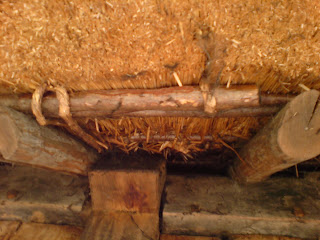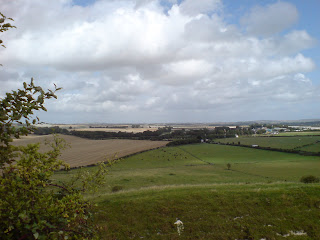The huge craft tents at Ludlow taken from the Keep
That's the thing about the Ludlow fayre is that it is very much a town event with market traders and local shops staying open late on the Saturday night with many getting dressed up in their most weird and wonderful fancy dress style 'medieval' costumes. Its not about reenactment style authenticity; its about taking part and having a good time. The whole town seems to join in and maybe that has something to do with the old fashioned air about the place. Many of the shops are very traditional in their displays, including the butchers with their produce still hanging outside their widows. There are old timber framed buildings dotted about all over the place that show Ludlow to have been a prosperous place. It must have been full of rich merchants who clearly liked to show their wealth in the excessive decorative woodwork in their houses; much more than was really needed to make them structurally sound. Our ancestors were into showing off just as much as we are today!
One of a number of butchers in Ludlow with pheasants for sale
The castle also demonstrates our ancestors need to keep up with the latest fashions and fads and its walls are covered in doors and windows from many different periods. Some are now walled up or the heavy wooden doors bolted shut, which all adds to the mystery of the place.One of many mullioned windows
There may be some cynics out there who just see it as yet another example of the over commercialisation of Christmas, but I don't think it is. Firstly the crafts on sale are all virtually unique and so show some thought has gone into them. Its not just a case of thumbing through the Argos catalogue or doing your shopping on line. I like that! And even though the fayre is predominately about spending money, many people come for the great festive entertainment.. There is of course storytelling and also archery, falconry and all the other things you'd expect at an historic fayre. But there is also lots of festive music, especially bagpipes. Now if you're like me your early experience of bagpipes was the endless screeching of many a Scotsman on the TV on New Years eve, but these are different. They include Northumbrian and various German pipes which are much softer sounding and are great when played with other medieval style instruments and a big drum! I defy anyone not to be drawn in.
People were dancing and singing along to the various Christmas choirs on site as well as eating and drinking and being very merry. Unfortunately the weather was not that good and there was plenty of rain, but what stood out to me is that it didn't get people down. Thousands turned up over the two days and every one was smiling. I'm not into the religious aspects of Christmas and prefer to treat it as a winter festival, a time of feasting and fun at the coldest and darkest time of the year and that's exactly how many of the visitors to the fayre seemed to treat it as well. A time to forget about credit crunches and wet weekends and to eat, drink and be very, very merry!
Thanks to Wynndbag and all the other entertainers and volunteers.




















































